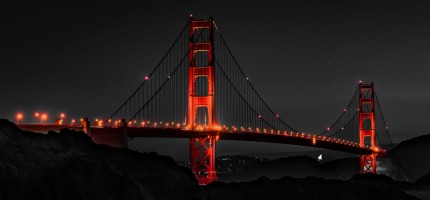 |
The Affordable Travel ClubTM Blog A Hospitality Exchange Club for People Over 40 |
| Home | Welcome | How it Works | Join | Locations | FAQ | Photos | Blog | Members Login |
|
RECENT TOPICS Covid-19 and ATC New Zealand - "Travel Local" Milepost Car Museums Aviation Museums Art and Specialty Museums Science Museums History Museums The Wild Wild West National Parks of the US Railroad Museums National Monuments and Memorials Landmarks Mt. St. Helens - 40 Years Ago Wine Country Cities of North America © The Affordable Travel Club |
Landmarks
Golden Gate National Recreation Area - As well as that world famous red suspension bridge, the Golden Gate area offers a world of natural delights, with over a thousand animal species and centuries of history spanning from the Native American settlement of California to the bustling metropolis of modern day San Francisco. No wonder 13 million visit its 80,000 acres every year. Much of the park is land formerly used by the United States Army. Alcatraz Island is part of this area. Serpent Mound - Peebles Ohio - An internationally known National Historic Landmark built by the ancient American Indian cultures of Ohio. It is an effigy mound (a mound in the shape of an animal) representing a snake with a curled tail. Nearby are three burial mounds - two created by the Adena culture (800 BC - AD 100), and one by the Fort Ancient culture (A.D. 1000-1650). Cahokia Mounds - Collinsville IL - Site of a pre-Columbian Native American city directly across the Mississippi River from modern St. Louis, Missouri. Monks Mound is the largest Pre-Columbian earthwork in the Americas and the largest pyramid north of Mesoamerica. The beginning of its construction dates from 900-955 CE. The mound size was calculated in 1988 as about 100 feet high, 955 feet long including the access ramp at the southern end, and 775 feet wide. This makes Monks Mound roughly the same size at its base as the Great Pyramid of Giza. Meteor Crater - A meteorite impact crater approximately 37 miles (60 km) east of Flagstaff and 18 miles (29 km) west of Winslow in the northern Arizona desert of the United States. Because the United States Board on Geographic Names commonly recognizes names of natural features derived from the nearest post office, the feature acquired the name of "Meteor Crater" from the nearby post office named Meteor. diameter: .74 mi depth 560 ft. 50000 years ago Odessa Meteor Crater - A meteorite crater in the southwestern part of Ector County, southwest of the city of Odessa of West Texas. It is accessible approximately 3 mi (5 km) south of Interstate 20 at Exit 108 (Moss Road).[1] This is one of three impact crater sites found in Texas, the others being the older and much larger Sierra Madera crater and the Marquez crater. Diameter 550 ft, Depth: 100 ft, Age: 63,500 years Blue Ridge Parkway - Known as "America's Favorite Drive", the Blue Ridge Parkway is a 470 mile wander through the mountains of the Appalachians that spans from North Carolina to Virginia, allowing you to get incredibly close to the majestic scenery right from the comfort of your car, but with plenty of opportunities for those who want to get out of their four doors and into nature. Natchez Trace Parkway - Extending roughly 440 miles from Nashville, Tennessee, to Natchez, Mississippi, linking the Cumberland, Tennessee, and Mississippi rivers, it roughly follows the "Old Natchez Trace" a historic travel corridor used by American Indians, "Kaintucks," European settlers, slave traders, soldiers, and future presidents. Today, people can enjoy not only a scenic drive but also hiking, biking, horseback riding, and camping along the parkway. Hoover Dam - - This dam was (and still is) an incredible feat of engineering, built around 30 miles east of the bright lights of Las Vegas. Completed in 1935, it saved the surrounding farmlands from frequent flooding by the Colorado River, but saw a death toll of 96 during its construction. Today, the dam attracts thousands of tourists who marvel at its sheer scale, but also the part it played in the development of Sin City and the field of engineering. Hearst Castle - Located on the central coast of California. It was designed by architect Julia Morgan for newspaper magnate William Randolph Hearst, who died in 1951. The castle features 56 bedrooms, 61 bathrooms, and once was the site of the world's largest private zoo. There is also the Neptune Pool, which gives visitors a scenic view of the mountains and the ocean, however, the pool is drained due to drought conditions. The Alamo - San Antonio Texas - The Alamo mission and fortress was a key site during the Texas revolution. It was the location of the fabled Battle of the Alamo in 1836, which saw the Texans fight off thousands of Mexicans in their fight for independence. The Alamo church, or "the shrine" as it is commonly known, is the heart of the complex: the names of the Texan soldiers who defended the mission can be found inscribed inside. Niagara Falls - On the New York - Ontario border. A group of three waterfalls at the southern end of Niagara Gorge, spanning the border between the US state of New York and the Canadian province of Ontario. The largest of the three is Horseshoe Falls, also known as Canadian Falls, which straddles the international border between Canada and the United States. The smaller American Falls and Bridal Veil Falls lie within the United States. Bridal Veil Falls are separated from Horseshoe Falls by Goat Island and from American Falls by Luna Island, with both islands situated in New York. |
